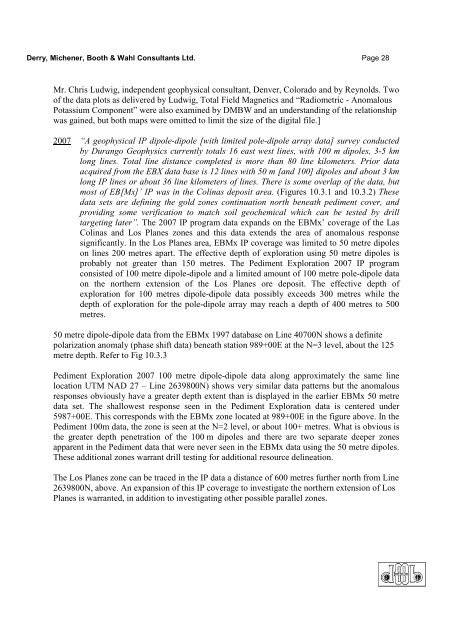43-101 2007 Technical Report On The San Antonio Project, Baja ...
43-101 2007 Technical Report On The San Antonio Project, Baja ...
43-101 2007 Technical Report On The San Antonio Project, Baja ...
Create successful ePaper yourself
Turn your PDF publications into a flip-book with our unique Google optimized e-Paper software.
Derry, Michener, Booth & Wahl Consultants Ltd. Page 28Mr. Chris Ludwig, independent geophysical consultant, Denver, Colorado and by Reynolds. Twoof the data plots as delivered by Ludwig, Total Field Magnetics and “Radiometric - AnomalousPotassium Component” were also examined by DMBW and an understanding of the relationshipwas gained, but both maps were omitted to limit the size of the digital file.]<strong>2007</strong> “A geophysical IP dipole-dipole [with limited pole-dipole array data] survey conductedby Durango Geophysics currently totals 16 east west lines, with 100 m dipoles, 3-5 kmlong lines. Total line distance completed is more than 80 line kilometers. Prior dataacquired from the EBX data base is 12 lines with 50 m [and 100] dipoles and about 3 kmlong IP lines or about 36 line kilometers of lines. <strong>The</strong>re is some overlap of the data, butmost of EB[Mx]’ IP was in the Colinas deposit area. (Figures 10.3.1 and 10.3.2) <strong>The</strong>sedata sets are defining the gold zones continuation north beneath pediment cover, andproviding some verification to match soil geochemical which can be tested by drilltargeting later”. <strong>The</strong> <strong>2007</strong> IP program data expands on the EBMx’ coverage of the LasColinas and Los Planes zones and this data extends the area of anomalous responsesignificantly. In the Los Planes area, EBMx IP coverage was limited to 50 metre dipoleson lines 200 metres apart. <strong>The</strong> effective depth of exploration using 50 metre dipoles isprobably not greater than 150 metres. <strong>The</strong> Pediment Exploration <strong>2007</strong> IP programconsisted of 100 metre dipole-dipole and a limited amount of 100 metre pole-dipole dataon the northern extension of the Los Planes ore deposit. <strong>The</strong> effective depth ofexploration for 100 metres dipole-dipole data possibly exceeds 300 metres while thedepth of exploration for the pole-dipole array may reach a depth of 400 metres to 500metres.50 metre dipole-dipole data from the EBMx 1997 database on Line 40700N shows a definitepolarization anomaly (phase shift data) beneath station 989+00E at the N=3 level, about the 125metre depth. Refer to Fig 10.3.3Pediment Exploration <strong>2007</strong> 100 metre dipole-dipole data along approximately the same linelocation UTM NAD 27 – Line 2639800N) shows very similar data patterns but the anomalousresponses obviously have a greater depth extent than is displayed in the earlier EBMx 50 metredata set. <strong>The</strong> shallowest response seen in the Pediment Exploration data is centered under5987+00E. This corresponds with the EBMx zone located at 989+00E in the figure above. In thePediment 100m data, the zone is seen at the N=2 level, or about 100+ metres. What is obvious isthe greater depth penetration of the 100 m dipoles and there are two separate deeper zonesapparent in the Pediment data that were never seen in the EBMx data using the 50 metre dipoles.<strong>The</strong>se additional zones warrant drill testing for additional resource delineation.<strong>The</strong> Los Planes zone can be traced in the IP data a distance of 600 metres further north from Line2639800N, above. An expansion of this IP coverage to investigate the northern extension of LosPlanes is warranted, in addition to investigating other possible parallel zones.











